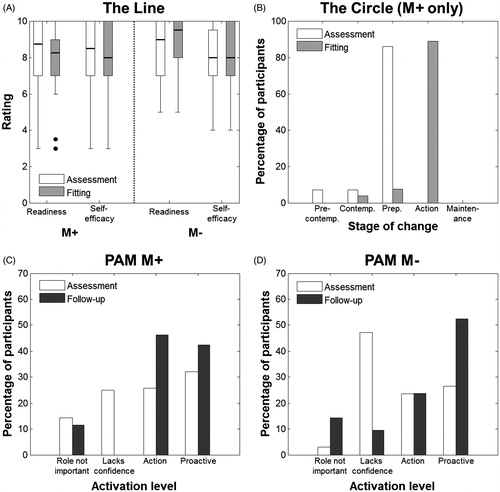Figures & data
Table 1. Reflections on the clinical use of the Motivation Tools. The participatory workshop revealed a number of take-home messages that are relevant to clinical practice.
Figure 1. (A) Boxplot showing median ratings for The Line questions 1 (Readiness) and 2 (Self-efficacy) at the assessment appointment and fitting appointment for M+ and M- groups. Line questions were used as the intervention with the M+ group, and with the M- group as a simple measure of readiness and self-efficacy only. (B) Percentage of M + participants classified by the audiologist according to one of five stages of change (The Circle) at assessment and fitting appointments. (C) Percentage of M+ participants falling within one of the four PAM Activation levels (see text) at assessment and follow-up. (D) Percentage of M- participants falling within one of the four PAM Activation levels at assessment and follow-up. PAM = Patient Activation Measure.

Table 2. Mean and standard deviation (or median and interquartile range) for self-report measures completed at assessment (HHCIR, HADS, PAM) and follow-up (HADS, PAM, GHABP, SADL, MARS-HA, datalogging), for both M+ (assessment, n = 32; follow-up, n = 28) and M- (assessment, n = 36; follow-up, n = 25) groups. Uncorrected p-value is provided for differences between groups, with bold indicating significance following Holm-Bonferroni correction. HHCIR = Hearing Health Care Intervention Readiness, HADS = Hospital Anxiety and Depression Scale, PAM = Patient Activation Measure, GHABP = Glasgow Hearing Aid Benefit Profile, SADL = Satisfaction with Amplification in Daily Life, MARS-HA = Measure of Audiologic Rehabilitation Self-efficacy for Hearing Aids.
Table 3. Significant (p <.05) Spearman rank (rs) correlation coefficients between HHCIR administered at assessment and outcome measures administered at follow-up for the M+ and M- groups. Bold indicates significance.
Table 4. Summary of multiple regression analysis for each outcome measure predicted by HHCIR scores based on significant Spearman rank correlation coefficients, for both M+ and M- groups. Bold indicates significance (p <.05).
